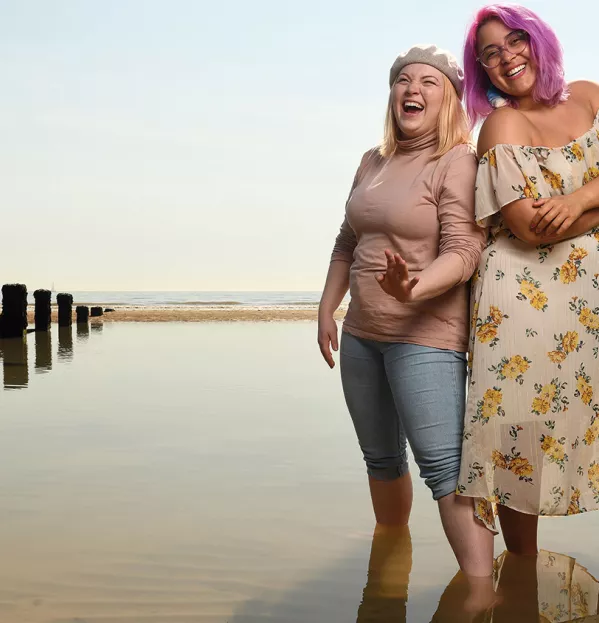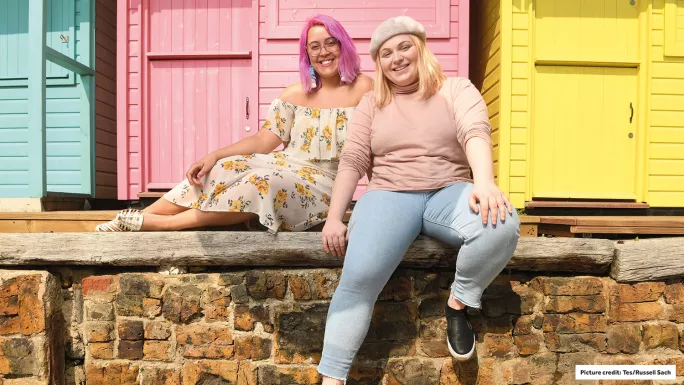Tes talks to... Megan Jayne Crabbe and Joeley Bishop

When Megan Jayne Crabbe was aged 14, she was removed from school, quietly and without fuss. Staff didn’t acknowledge that she was missing and pupils’ questions about her absence went unanswered. Her departure was brushed under the carpet so effectively that even her best friend, Joeley Bishop, had no idea where she was.
This is a sequence of events that many who were in the schools system a decade ago would recognise. Crabbe had been taken out of school to treat the eating disorder that had plagued her for years. The secrecy of the departure was relatively normal in these cases. People did not feel comfortable talking about anorexia or bulimia. Many still don’t.
Ten years on, Crabbe and Bishop are trying to break that silence and tackle some of the contributing factors of eating disorder. Both are leading figures in the fast-growing body-positivity movement that provides an antidote to the popular “fitspo” and “thinspo” pictures that flood Instagram and Tumblr, which infer that to be valued, we should appear a certain way. The body-positive community post unedited photographs of their faces and bodies, along with inspirational messages of acceptance, reminding us that no matter your size, shape, skin colour or ability, you have value. And this message is one that the pair believe schools should take more notice of if children are to be supported to be happy in their own skin.

“Images of slender, toned, retouched bodies are everywhere,” says Crabbe (@bodyposipanda on Instagram). “We see them more today than ever before because of the internet. Kids are going to see them and we can’t stop that. But we can show them reality…we can show them images that haven’t been edited and bodies that haven’t been starved and punished until they fit an ideal. And if they see themselves represented somewhere by someone positive who’s living a happy, fulfilled life, that’s got to help.”
Crabbe in particular has painful memories of body image during her school days. “When I was in Year 3, the weighing of children - and sending a letter home if they were overweight - was introduced [The National Child Measurement Programme]. I found that such a scary and humiliating prospect. I was really well-behaved, but I refused to be weighed because I was certain that my weight would be the highest in the class. It was the first time I had ever been defiant - the shame was that strong.”
The programme is still in effect today, measuring Reception and Year 6 children (see bit.ly/NHSNCMP). It’s based on body mass index (BMI) charts and flags up children who fall within an “unhealthy” weight range.
Crabbe believes BMI is flawed. “It’s an outdated system,” she argues. “Points for the cut-offs for underweight, overweight, and so on, were lowered several years ago, so people who once had a healthy BMI may now be classed as overweight without their weight changing at all. It doesn’t take into account different body types and gives no holistic view of health. It’s just used as a shaming tool, and it’s a shame that it’s seen as the benchmark for health because people’s health is about more than being stuffed into a weight category.”
Bishop (@thevagaggle on Instagram) agrees. “People misunderstand how weight affects health,” she says. “You can be overweight and perfectly healthy.”
What body positivity aims to do is not legitimise unhealthy lifestyles (as some have criticised it for doing), but to take the focus away from appearance as being the key identifier of self.
“Body positivity is about encouraging people to embrace themselves as they are and to realise that they are more than how they look,” says Crabbe.
“It’s so obvious when you think about it,” adds Bishop. “But it’s a message that kids aren’t getting, and the reason they’re not getting it is because it’s so firmly entrenched in our culture that it isn’t questioned. And that’s a shame because we are doing ourselves a disservice.
“When people understand that they are more than how they look, they push for more in their lives - they explore bigger and better issues than their looks. That is why body positivity is so important.”
Schools are arguably more advanced on this than society in general. Many pastoral teams focus intently on positive body image, and in those schools in which personal, social, health and economic education has remained a fixture on the curriculum, the very best practice sees body positivity throughout school. But the pair argue that this is not yet the norm, and they believe the answer is not as simple as just teaching pupils about it; much of the way that young people see their bodies depends on the actions of the adults around them, including teaching staff.
Crash dieting ‘celebrated’
Bishop, a dance teacher who is training to become a counsellor, but who was until recently a learning-support assistant, believes the culture of dieting among teachers - and celebration of weight loss - is still too prevalent in schools.
“Teachers think that kids don’t pick up on discussion of weight and diets, but they do,” she says. Bishop cites an example of a school in which teachers very publicly competed to lose weight, with updates spread around the school about progress made.
“The kids were hearing constant banter about weight-loss competition,” she says. “It’s so damaging for anyone who is struggling with body image or an eating disorder to see a celebration of crash dieting, and when it relates to their role models, it’s even more so.
“I constantly heard kids talking about how much they hated their bodies and how much weight they wanted to lose, particularly when prom was approaching. Not a week went by without me having to challenge these thoughts. It’s so sad that children feel this way at all and we need to think carefully about how we are unconsciously reinforcing these damaging beliefs.”
In some instances, the curriculum can be problematic, too. Evil characters are often described as fat or ugly in children’s books. Even Harry Potter contains fat jokes. Meanwhile, at secondary, Instagram and Tumblr are popular with teenagers and introduce them to a world in which everyone is slender and has clear skin thanks to photo-editing apps and filters, and a culture in which photos of “perfect” bodies, and diet and fitness advice, are reblogged by thousands.
As adults, it might be easy to see through all of this, but we need to understand that teens might not, argues Crabbe.
“Kids and teens are so susceptible to these messages,” she says. “I used to truly believe that controlling my food intake and exercising obsessively was what I had to do; it never occurred to me that I had a choice. If that’s the only narrative that you’ve ever been given, then that’s how you’ll live your life. We need to work so hard to change that.”
This is why the role of schools is important, but she feels they could be doing a lot more than they currently do.
“The problem is that schools can be apathetic,” she says. “They can’t see how it benefits them to teach their pupils to be body positive. But if a child is not getting enough calories and nutrients, their brain will not function as well as it could. And if you’re obsessing about weight loss and calories all day, you are not concentrating on your work.”
Bishop adds that “to ignore the body-image problem that young people have is to ignore their potential”.
“You can’t be the best student you can be unless you feel good about yourself to start with,” she says.
Bringing in advocates
So, what could schools be doing to improve their pupils’ body image?
“Staff need to look inwards and think about how they talk about themselves,” says Bishop. “Stop self-deprecating jokes about the way they look, and stop talking about their diets in front of pupils. And challenge what pupils say about themselves.”
Crabbe stresses that this is not always about teachers delivering messages; she is a big advocate of schools bringing external people in to chat to students. “It’s crucial to get people into schools to talk about it,” she says. “It’s difficult because funding for any mental health issues in schools is so limited, but it makes a difference if kids can see positive people talking about body image. I spoke in a school recently to a group of Year 11 girls. They were silent throughout, but afterwards they stayed to ask questions and some burst into tears. They told me that they weren’t used to talking about it - that they didn’t know that it was OK to do that.
“And I understand because we never knew that body positivity existed at their age. We had to find it ourselves. They need to know that there is an option - that there’s a different way they can think, that they don’t have to hate themselves. I never knew that. I didn’t realise that I had a choice.”
Finally, Crabbe and Bishop believe schools should begin to correct misunderstandings about what a healthy body looks like.
“The Health at Every Size movement is a great starting point,” says Crabbe. “Schools need to be teaching children that good health looks different on everyone. You can have healthy habits at every size. If we teach kids to eat a varied diet and move for the joy of it, then that is teaching them to be healthy.”
“We need a more holistic view of health,” adds Bishop. “Mental health is part of that, too, and restricting food or exercising obsessively damages that.
“There also needs to be an emphasis on the effect that extreme dieting and being underweight can have on health, as this currently doesn’t get addressed as much as being overweight. It works both ways.”
Both are conscious that schools are attacked from every angle on so many issues, and they do not want to add yet another voice of criticism. Instead, they would like to be more of a guide, presenting the issues and solutions they have discovered, and letting the experts - the teachers - do the rest.
“We’re not teachers,” says Crabbe. “We know that there will be problems about getting our message into schools that we’re not even aware of yet, but we live this and we see first-hand the huge amount of young people who struggle with finding body positivity and how they grow once they understand the message.
“That’s what we all want for young people, isn’t it: the chance to fulfil their potential.”
Lisa Jarmin is a freelance writer. Megan Jayne Crabbe’s book, Body Positive Power, is out now
You need a Tes subscription to read this article
Subscribe now to read this article and get other subscriber-only content:
- Unlimited access to all Tes magazine content
- Exclusive subscriber-only stories
- Award-winning email newsletters
Already a subscriber? Log in
You need a subscription to read this article
Subscribe now to read this article and get other subscriber-only content, including:
- Unlimited access to all Tes magazine content
- Exclusive subscriber-only stories
- Award-winning email newsletters